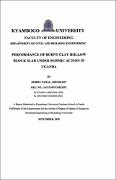| dc.description.abstract | A storeyed building has different structural elements each working to complement the other in
resisting seismic actions. Since most of the building mass is present at floor levels, earthquake induced
inertia forces primarily develop at the floor levels due to ground vibrations from which
they travel horizontally through the slabs and beams to columns and wa11s, and then to the
foundations where they are dispersed to the ground.
Ninety five percent (95%) of storeyed buildings in Kampala the capital city of Uganda have their
slabs constructed with burnt clay ho11ow block reinforced concrete slabs. Slabs containing hollow
blocks are constructed with the hollow side of blocks end to end running in one direction, with a
rib between rows of blocks in which steel reinforcement is laid. This constrains the slab to act as
one-way spanning.
For a structure subjected to seismic loading, the requirement for a diaphragm is that the slab should
have equal strength in both horizontal directions. This is because horizontal seismic action is
described by two orthogonal components considered as independent and represented by the same
response spectrum. According to EN 1998, (Euro Code 8), one of the guiding principles governing
conceptual design against seismic hazard is the bi-directional resistance and stiffness at storey level.
Seismic load is applied to the slab as a compressive load in the plane of the slab. This study
determined the load capacity of hollow blocks parallel and perpendicular to the boles in the plane
of the slab.
Hollow block slabs measuring 750 x 800mm were produced. These were cured for 28days and
loaded parallel and perpendicular to the direction of hollow blocks and ribs. Also, the hollow blocks
were loaded parallel and perpendicular to the direction of holes. It was found that the load capacity
of burnt clay hollow blocks when loaded parallel to holes varied from I 03.35kN - l 23.93kN giving
a compressive stress of 2.3 /mm2
- 2.8N/mm2
, whereas the load capacity, perpendicular to the
direction of holes ranged from 45.6kN - 47.4kN giving a compressive strength of I .ON/mm2 -
l.05N/rnm2•
For the slab, the failure load varied from 3 I 5kN - 375kN when loaded parallel to the rib, giving a
stress of l .97N/mm2 - 2.34N/mm2 and the failure stress perpendicular to ribs varied from
l.04N/nun2 - l.2N/mm2. | en_US |

